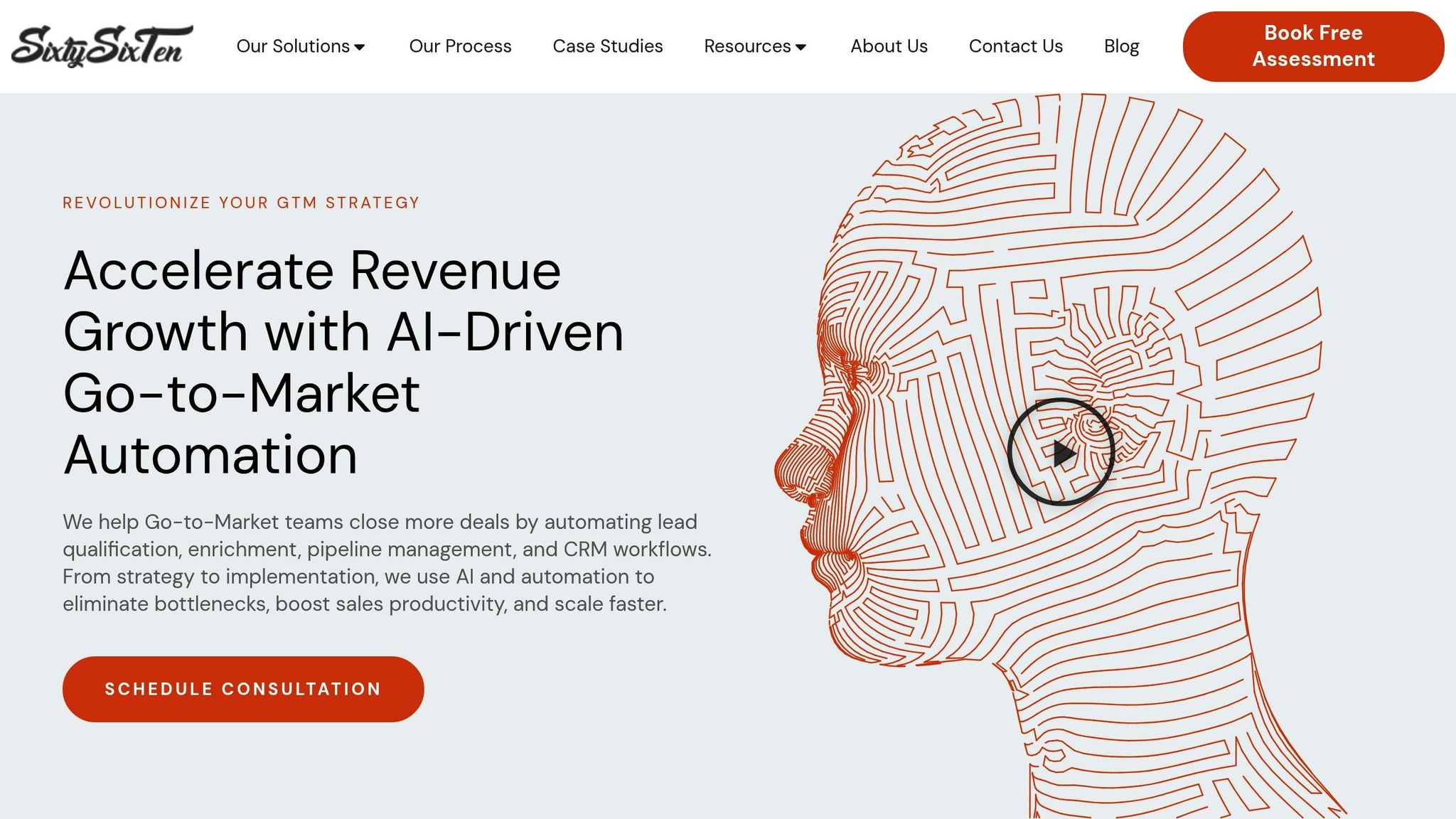AI is transforming how B2B SaaS companies scale their go-to-market (GTM) workflows. By automating repetitive tasks and enabling smarter decision-making, businesses can handle more leads, manage complex pipelines, and personalize customer interactions – without expanding their teams. Here’s what you need to know:
- AI Benefits: Automates lead scoring, sales enablement, and revenue forecasting with precision.
- Key Challenges Solved: Eliminates data silos, reduces inefficiencies in lead qualification, and standardizes sales processes.
- Use Cases: AI-powered tools improve lead prioritization, personalize outreach, and predict pipeline risks.
- Scalable Frameworks: Modular designs with real-time data synchronization ensure flexibility and efficiency.
- Tool Choices: No-code/low-code platforms like Clay offer quick deployment, while custom solutions provide tailored capabilities.
AI doesn’t replace human expertise – it amplifies it, allowing teams to focus on high-value activities like closing deals and building relationships. Companies like OpenAI and Anthropic have already seen measurable results, including faster workflows and improved lead management. Ready to scale smarter? AI-powered GTM workflows might be the key.
Beyond Copy: How To Use AI to Build GTM Systems That Scale
AI Use Cases in Scalable GTM Workflows
AI is transforming GTM (go-to-market) strategies by embedding smart automation into every corner of the workflow. It goes beyond basic task automation, introducing intelligent decision-making into areas like lead scoring, sales enablement, and revenue forecasting. This integration sets the stage for more advanced capabilities, such as targeted prospecting.
Lead Scoring and Smart Prospecting
AI takes lead scoring to the next level by analyzing a wide range of data – like website activity, email engagement, and company growth metrics – to deliver precise lead evaluations. This approach ensures greater accuracy compared to traditional methods.
When it comes to prospecting, AI identifies potential leads by studying the traits of your best customers. It scans massive company databases to pinpoint organizations with similar characteristics and growth patterns, prioritizing leads based on their likelihood to convert and potential value.
AI-powered prospecting agents also personalize outreach at scale. By analyzing factors like recent company news, social media activity, and industry trends, these tools craft messages that address specific challenges prospects face. They efficiently qualify inbound leads through chatbots or targeted email campaigns, ensuring high-value leads are quickly routed to sales teams.
Sales Enablement and Pipeline Management
AI supercharges sales enablement by delivering real-time insights. By analyzing patterns from successful deals, AI tools suggest the best next steps – whether it’s a timely follow-up or sharing proven content. If deals hit roadblocks, AI recommends actions like involving additional stakeholders or using specific materials that have worked in similar scenarios.
Content recommendation engines further support sales teams by tailoring resources to each prospect. Based on industry, company size, role, and buying stage, AI suggests the most relevant case studies, demos, or technical documents to make a stronger impact.
Pipeline management also benefits from AI’s predictive capabilities. These systems monitor deal progress and flag any deviations from expected timelines. Automated follow-up sequences adapt to prospect behavior – for example, switching to alternative outreach methods if emails are ignored – helping sales teams keep deals on track. This guidance seamlessly integrates into AI-powered revenue forecasting.
Predictive Analytics and Revenue Forecasting
AI-driven analytics revolutionize revenue forecasting by making it a highly data-driven process. By examining historical deal data, seasonal trends, team performance, and market conditions, these tools deliver forecasts with improved accuracy.
AI continuously assesses deal risks by monitoring factors like email response times, meeting participation, and stakeholder engagement. If multiple risk indicators align, the system alerts sales managers, offering a chance to address potential issues before they escalate.
Additionally, AI models various scenarios to help businesses understand how changes in marketing budgets or sales capacity could impact lead generation and revenue. Customer lifecycle analytics play a key role here, identifying upsell opportunities or early signs of churn, enabling proactive account management.
Together, these AI tools create a seamless intelligence layer across GTM workflows. Accurate lead scoring enhances sales enablement, which in turn feeds into more precise predictive analytics. This continuous feedback loop enables scalable GTM operations while maintaining the personalized approach that’s critical for B2B success.
Building Scalable AI-Powered Automation Frameworks
Creating scalable AI automation frameworks is all about building systems that can grow alongside your business without sacrificing performance. For established B2B SaaS companies, this means designing frameworks that can handle increasing lead volumes and complex sales cycles with ease.
The starting point? Understand your current go-to-market (GTM) processes and identify where AI can make the biggest impact. This requires mapping out your revenue funnel – from finding prospects to ensuring customer success – and spotting the bottlenecks caused by manual workflows.
From there, focus on modular designs, smart integration choices, and real-time data to create a unified automation strategy.
Modular Workflow Design with AI Integration
The key to scalability lies in modular design. Instead of relying on large, unwieldy systems, break your processes into smaller, connected modules that can be updated, replaced, or scaled independently. This structure allows you to test and implement new AI capabilities without disrupting the entire system.
Each module should serve a clear purpose in your GTM process. For instance, one module might use AI to enrich lead data, while another automates email sequences based on engagement scores. The modules should communicate seamlessly through standard data formats and APIs, with AI acting as the central intelligence that ties everything together.
AI tools shouldn’t operate in silos. For example, when your lead scoring AI identifies a high-value prospect, that insight should automatically update your CRM, adjust nurturing campaigns, and trigger actions in your sales enablement tools. This interconnected approach ensures your entire framework works as a cohesive unit.
Modular design also makes it easier to adapt as your business evolves. Whether you’re expanding into new territories or scaling up operations, you can add or modify components without overhauling the entire system.
As your framework grows, maintaining consistent data across all modules becomes crucial. Whether it’s personalizing emails or updating pipeline forecasts, AI tools need access to the same enriched prospect data. This requires setting clear data standards and ensuring every module adheres to them.
Once your modular design is established, the next step is deciding between no-code/low-code platforms and custom-built solutions.
No-Code/Low-Code vs Custom Solutions
Choosing between no-code/low-code platforms and custom solutions is a critical decision that affects scalability and maintenance. Each option has its strengths, depending on your team’s technical expertise and specific needs.
No-code/low-code platforms like Make, Clay, and n8n allow teams to quickly build and test workflows without writing code. For example, Make offers over 3,000 app integrations and 400+ AI app connections, while Clay connects to 150+ data providers, making it ideal for lead enrichment and prospecting workflows.
"Clay enables our team to rapidly experiment with trigger-driven workflows and third-party enrichment data. We’re able to move fast and drive outsized impact on GTM execution." – Scotty Huhn, Revenue Strategy & Data Lead, OpenAI
OpenAI’s success with no-code platforms highlights their potential. By using Clay, they increased their lead enrichment coverage from the low 40% range to over 80%. This was achieved by consolidating multiple data sources and automating quality checks across their prospect database.
Custom solutions, on the other hand, are better suited for complex or highly specialized needs. These might include proprietary AI models trained on your customer data, integrations with legacy systems, or advanced algorithms for tasks like territory management or commission calculations.
Often, the best approach combines both strategies. Take Anthropic’s Revenue Operations team as an example. They streamlined their tech stack to core tools – CRM, Clay, and email software – saving four hours per week by automating lead enrichment and scoring in Salesforce while ensuring 100% automated updates for opportunities.
"Clay has helped Anthropic significantly improve our lead enrichment and sales data pipelines." – Adam Wall, Head of Revenue Operations, Anthropic
When evaluating platforms, it’s important to consider the total cost of ownership. No-code platforms typically involve subscription fees that scale with usage, while custom solutions require upfront development and ongoing maintenance. For high-volume or specialized operations, custom solutions often offer better long-term value.
With your platform in place, ensure your framework supports real-time data flows for maximum efficiency.
Real-Time Data and Reporting
Real-time data synchronization is the backbone of any scalable AI-powered GTM framework. Without it, AI agents risk making decisions based on outdated information, leading to missed opportunities and subpar customer experiences.
Real-time systems rely on trigger-based workflows that instantly update whenever there’s a data change or intent signal. For example, a prospect’s action – like clicking a link – should immediately update your CRM, adjust their lead score, and trigger follow-up outreach.
Managing real-time data at scale requires careful planning. High-volume operations must handle thousands of webhook calls per hour while ensuring data accuracy. Queue systems and batch processing can help manage non-critical updates, while high-priority signals should trigger immediate actions.
Continuous data synchronization keeps all GTM tools aligned. Instead of relying on periodic uploads, modern frameworks push updates to CRMs, data warehouses, and reporting tools as soon as new information becomes available. This ensures teams always have access to the most up-to-date data, eliminating the risks of outdated prospect information or misaligned marketing efforts.
As these systems grow more complex, visual monitoring tools become essential. Real-time dashboards allow teams to track data flows, identify bottlenecks, and measure business impact metrics like lead conversion rates and pipeline velocity.
Breaking down data silos across departments further enhances efficiency and decision-making. When marketing, sales, and customer success teams all operate from the same real-time data foundation, AI agents can provide better recommendations, and automation sequences can adapt to the full customer journey rather than isolated interactions.
Investing in robust real-time data infrastructure pays off as your GTM framework scales. It enables teams to respond quickly to market opportunities, deliver better experiences for prospects, and make confident, data-driven decisions based on the most current information available.
sbb-itb-647c22e
Best Practices for Scaling GTM Workflows with AI
Expanding GTM workflows with AI is all about removing manual roadblocks and fostering continuous improvement. Building on modular design and real-time data principles, these best practices aim to simplify the process of scaling. The key is to identify time-consuming processes, automate them without compromising quality, and ensure your team can focus on tasks that truly matter.
Automating Repetitive GTM Tasks
Repetitive tasks are prime candidates for automation. By delegating these to AI, you free up resources, improve efficiency, and maintain accuracy.
- CRM Updates: AI can handle real-time lead scoring, enrich contact records with company data, and manage opportunity stages based on prospect behavior. For example, it can automatically update deal stages after an email reply or flag high-priority leads for immediate attention.
- Email Segmentation and Scheduling: AI tools analyze prospect behavior to optimize send times, craft personalized subject lines, and adjust messaging based on engagement rates. This ensures personalization at scale without extra manual effort.
- Reports and Dashboards: Automating report generation saves hours of manual work. AI can pull data from multiple sources, calculate metrics, and format reports tailored to stakeholders – think weekly pipeline updates or lead quality assessments.
- Lead Scoring and Routing: Using firmographic data, behavioral patterns, and historical trends, AI can score leads and route them to the right sales representatives based on criteria like territory or expertise.
Starting with high-volume, straightforward tasks builds trust in AI systems and delivers measurable time savings. Once confidence grows, teams can tackle more complex automations.
Data Integration Across Systems
Scaling workflows with AI requires breaking down silos between tools like your CRM, marketing automation platform, and analytics systems. When these systems operate in isolation, AI decisions are often based on incomplete data, leading to missed opportunities.
- Unified Customer Profiles: Real-time synchronization across platforms ensures consistency. For instance, when a prospect interacts with your marketing platform, their CRM record should update instantly, adjusting lead scores and triggering follow-ups.
- Cross-Platform Workflow Triggers: Automate sequences that span multiple tools. If someone downloads a whitepaper, their lead score can update, they can be added to an email nurturing sequence, and their assigned sales rep can be notified – all within minutes.
- Standardized Data Formats: Establish common field mappings and validation rules to maintain data quality as it flows between systems. This ensures AI agents always work with accurate, consistent information.
- API-First Integration: While pre-built integrations handle basic syncing, custom APIs enable advanced automation and real-time data processing tailored to your business needs.
Bidirectional data flows are essential. Updates in one system should immediately reflect across all others, ensuring AI decisions are informed by the most current data.
Continuous Optimization Through Unified Dashboards
Dashboards provide the visibility needed to fine-tune AI-powered workflows. Without centralized monitoring, it’s difficult to pinpoint which automations are effective and where manual adjustments are still necessary.
- Real-Time Visual Maps: These tools let teams monitor data flows, track automation performance, and quickly spot issues. A clear visual overview of your automation ecosystem helps maintain control and identify areas for improvement.
- Performance Tracking Dashboards: Combine operational metrics (like automation execution rates and data quality scores) with business outcomes (like lead conversion rates and customer acquisition costs). This holistic view links AI performance to tangible results.
- Bottleneck Identification: Dashboards can highlight where prospects drop off, which automations are underperforming, and where manual intervention is most frequent. This data-driven insight ensures optimization efforts are targeted and effective.
- A/B Testing Frameworks: Built-in testing tools allow teams to experiment with different workflows – like lead scoring models or email personalization techniques – and monitor results in real time. This iterative approach ensures AI systems evolve and improve.
The best dashboards go beyond operational monitoring to offer strategic insights. They help predict trends, guide decisions, and support ongoing workflow improvements. Teams using visual-first platforms with real-time monitoring can proactively optimize their GTM operations, turning dashboard insights into actionable strategies for long-term success. By continuously refining AI-powered workflows, businesses can achieve consistent gains in efficiency and performance.
Comparing Automation Approaches for GTM Workflow Scaling
Building on the frameworks we’ve discussed, let’s dive into how different automation methods can refine your GTM strategy. Picking the right approach can make or break your ability to scale efficiently. Each option comes with its own strengths and challenges, so understanding these differences is key to aligning with both your current needs and long-term goals.
No-Code/Low-Code Platforms vs Custom-Coded Solutions
Deciding between no-code/low-code platforms and custom-coded solutions often boils down to speed versus specificity. Both can support scaling efforts, but each serves distinct business scenarios.
| Feature | No-Code/Low-Code Platforms | Custom-Coded Solutions |
|---|---|---|
| Scaling Ability | Built for high-volume data processing with visual tools | Tailored for unique needs with custom scalability |
| Cost | Lower upfront costs with subscription pricing | Higher investment upfront with ongoing maintenance |
| Flexibility | Flexible within platform ecosystems with pre-built integrations | Fully customizable for precise requirements |
| Deployment Speed | Quick setup with drag-and-drop interfaces | Longer timelines requiring specialized coding |
No-code or low-code platforms are perfect when speed is critical, offering rapid deployment and a range of integrations. On the other hand, custom solutions shine when workflows require unique logic or integrations that off-the-shelf tools can’t handle.
For many scaling businesses, a hybrid approach works best. Companies like SixtySixTen often combine no-code platforms for quick wins with custom solutions for specialized needs. This way, they balance speed and flexibility, ensuring they’re ready for both immediate demands and future complexities.
Manual vs AI-Driven GTM Workflows
The operational approach – whether manual or AI-driven – plays a significant role in GTM performance as you scale.
| Aspect | Manual GTM Workflows | AI-Driven GTM Workflows |
|---|---|---|
| Efficiency | Limited by human capacity and hours | Runs 24/7 with steady performance |
| Accuracy | Prone to human error, especially on repetitive tasks | Consistently accurate with learning capabilities |
| Scaling Ability | Requires adding more team members for higher volume | Scales without increasing headcount |
| Cost Structure | Costs grow with team size | Costs decrease per unit as volume increases |
| Response Time | Depends on team availability | Processes data and responds almost instantly |
Manual processes can work for small-scale operations but often create bottlenecks as volume grows. For instance, a sales rep manually updating CRM records may handle a few dozen leads, while an AI system can process thousands, ensuring data accuracy and triggering follow-ups automatically.
AI-driven workflows also excel in speed. Tasks like lead scoring and routing, which might take hours manually, can be completed in minutes with AI, keeping momentum high and improving conversion rates.
Integrated Systems vs Single-Point AI Tools
The level of system integration is another critical factor in scaling your GTM operations. Unified platforms offer a seamless experience, while single-point tools handle specific tasks but often come with limitations.
Integrated systems, like those used by SixtySixTen, break down data silos and unify tools for lead scoring, email automation, and CRM updates. This approach offers several key benefits:
- Seamless Data Flow: Information moves smoothly across tools. For example, when a prospect engages with your content, their lead score updates instantly, triggering personalized emails and sales alerts.
- Informed Decision-Making: AI systems with access to complete customer profiles can make more accurate decisions, considering the entire customer journey, unlike single-point tools that rely on isolated data.
- Operational Efficiency: Integrated systems streamline workflows, improving lead enrichment and data pipelines while reducing the need for multiple tools.
- Faster Experimentation: Unified platforms make it easier to test new workflows and incorporate third-party data, allowing teams to adapt quickly.
- Cost Savings: By consolidating subscriptions and reducing complexity, integrated systems optimize costs while enhancing functionality.
Integrated platforms also provide a clear view of data flow, helping teams identify optimization opportunities and troubleshoot issues more easily. While single-point tools can be useful for specialized tasks or testing, a unified system is often the better choice for long-term GTM scaling.
Conclusion: GTM Scaling with AI
Shifting from manual processes to AI-driven Go-to-Market (GTM) workflows can revolutionize operations and pave the way for scalable growth in post-Product-Market-Fit (PMF) B2B SaaS companies. Throughout this guide, one thing has become clear: companies that effectively scale their GTM efforts don’t see AI as a replacement for human expertise. Instead, they use it as a tool to enhance their team’s capabilities, making them faster, smarter, and more efficient.
Key Takeaways for Scaling GTM Workflows
Building scalable GTM workflows relies on three essential pillars, each working together to fuel sustainable growth:
- AI-powered automation: Automating repetitive tasks like lead scoring, data enrichment, and pipeline management allows your team to focus on high-value activities like closing deals and nurturing relationships. AI works tirelessly around the clock, processing thousands of leads with consistent accuracy.
- Flexible, modular workflows: By adopting workflows that can adapt to changing market conditions, you can experiment and optimize quickly. This approach lets you integrate new tools, data sources, and processes without needing to overhaul your entire system.
- Real-time optimization through unified dashboards: Integrated dashboards give you a clear view of your GTM data, making it easier to identify bottlenecks, track performance, and make informed decisions. Over time, these data-driven decisions lead to compounding improvements in efficiency and results.
To implement these pillars effectively, you need a partner with both technical expertise and a deep understanding of GTM strategies.
Why SixtySixTen is the Right Partner for GTM Automation

Scaling GTM workflows requires more than just tools – it demands a partner that can align technology with your business goals. SixtySixTen specializes in this intersection, offering engineering-backed solutions tailored to post-PMF B2B SaaS companies.
"We help Go-to-Market teams close more deals by automating lead qualification, enrichment, pipeline management, and CRM workflows. From strategy to implementation, we use AI and automation to eliminate bottlenecks, boost productivity, and scale operations."
What sets SixtySixTen apart is their approach. They don’t push businesses into rigid templates or one-size-fits-all solutions. Instead, they act as engineering partners, combining consulting expertise with hands-on implementation. Using tools like Clay, n8n, and custom AI agents, they create solutions tailored to your unique needs and existing tech stack.
Their results speak for themselves: SixtySixTen has helped clients achieve a 30% revenue increase and 2.5x more efficient GTM operations. These outcomes stem from their focus on three core areas – automating processes for scalability, improving precision with real-time lead scoring and segmentation, and accelerating workflows to speed up follow-ups and pipeline handoffs.
"Our GTM automation engineers combine consulting and implementation to help you streamline how leads enter and move through your funnel. We build using tools like Clay, n8n, and custom AI agents, integrating directly with your existing CRM, sales tools, and outbound platforms."
With a track record of success across 100+ customers worldwide, SixtySixTen demonstrates that scaling doesn’t require growing your team – it’s about optimizing your processes. Their full lifecycle support ensures your AI-powered GTM workflows continue to evolve as your business grows, providing a solid foundation for efficient, sustainable expansion in today’s competitive landscape.
FAQs
How can AI-driven GTM workflows help streamline lead management and sales without adding more staff?
AI-powered go-to-market (GTM) workflows simplify lead management and sales by automating repetitive tasks and supporting better decision-making. With AI in the mix, tasks like updating CRM systems, scoring leads, and managing outreach become more efficient, giving sales teams more time to concentrate on closing deals.
These workflows also improve targeting and personalization by enabling real-time lead enrichment, segmentation, and scoring. This means sales teams can focus their efforts on high-priority leads, boosting productivity and scaling operations without the need to grow the team.
How does a modular AI automation framework help scale GTM operations?
A modular AI automation framework helps businesses streamline their go-to-market (GTM) operations by breaking down intricate workflows into smaller, more manageable pieces. This method provides the flexibility to adjust processes, speeds up implementation, and allows for easier customization tailored to specific business needs.
With modular frameworks, businesses can seamlessly integrate tools for lead scoring, sales enablement, and automated workflows across various platforms like CRM, email, and reporting systems. The result? Less manual effort and improved efficiency, paving the way for smoother operations and scalability as business requirements change.
What’s the difference between using no-code/low-code platforms and custom solutions for integrating AI into GTM workflows?
SixtySixTen uses a mix of no-code/low-code platforms and custom development to seamlessly incorporate AI into go-to-market (GTM) workflows. Tools like n8n, Zapier, Make.com, and Clay.com are great for automating tasks quickly and cutting down on manual work. But when these platforms can’t handle more complex or specific business needs, custom-coded solutions step in to deliver the precision and scalability required.
This combination allows SixtySixTen to build tailored systems that enhance lead scoring, improve sales enablement, and refine other GTM processes. The result? Businesses can streamline their operations and achieve steady, long-term growth.



